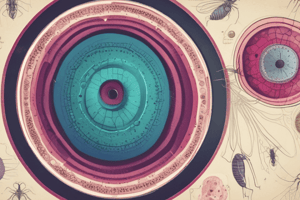Podcast
Questions and Answers
Which species of Plasmodium is known to cause malignant tertiary malaria?
Which species of Plasmodium is known to cause malignant tertiary malaria?
- Plasmodium falciparum (correct)
- Plasmodium vivax
- Plasmodium ovale
- Plasmodium malariae
What is the primary site of pre-erythrocytic schizogony in avian malarial parasites?
What is the primary site of pre-erythrocytic schizogony in avian malarial parasites?
- Spleen
- Liver parenchyma
- Bone marrow
- Mesoderm (correct)
Which symptoms are characteristic of Plasmodium vivax infection?
Which symptoms are characteristic of Plasmodium vivax infection?
- Severe abdominal pain
- Daily shivers and seizures
- Chronic cough and fatigue
- High temperature and perspiration (correct)
How long can untreated Plasmodium malariae infection potentially last?
How long can untreated Plasmodium malariae infection potentially last?
What is a unique property of Plasmodium falciparum affecting the brain?
What is a unique property of Plasmodium falciparum affecting the brain?
Flashcards are hidden until you start studying
Study Notes
Simian Parasites
- Plasmodium species infecting monkeys/apes include P.cynomolgi, P.fragile, P.fieldi, P.hylobati, P.simiovale, and twenty others.
- These parasites share biological traits with human malaria parasites.
Avian Parasites
- Common avian Plasmodium species: P.gallinaceum, P.lophurae, P.elongatum, P.relictum, P.fallax.
- Avian parasites undergo pre-erythrocytic schizogony in the mesoderm, unlike mammals where it occurs in the liver.
Reptilian Parasites
- P.wenyoni is the sole malarial species infecting snakes.
- Malarial parasites are prevalent in lizards but not found in crocodiles.
Human Malarial Parasites
- Plasmodium vivax: Causes benign tertiary malaria with symptoms like headache, nausea, vomiting, and high fevers lasting up to a year if untreated.
- Plasmodium ovale: Similar symptoms to P.vivax; untreated lasts about a year.
- Plasmodium malariae: Causes quaternary malaria with 72-hour fever cycles; can last up to 20 years untreated.
- Plasmodium falciparum: Leads to malignant tertiary malaria and can cause severe complications like brain hemorrhage, coma, or death.
Morphological Differences
- Blood stages vary among Plasmodium species, aiding in differentiation:
- P.falciparum: Smaller, numerous ring stages, and frequent multiple infections.
- P.vivax: Engorged erythrocytes exhibiting Schüffner's dots; ameboid trophozoite shape with over 20 merozoites.
- P.ovale: Similar to P.vivax but generally a more compact form.
- P.malariae: Compact forms with formation of rosettes of merozoites (8-10 per schizont).
Characteristics of Plasmodium Species
- P.falciparum: Not enlarged host cells, dark pigment (Maurer’s dots), compact structure with multiple trophozoites.
- P.vivax: Enlarged, round/oval host cells, golden brown granules with Schüffner's dots.
- P.malariae: Regularly shaped with pigment granules, minimal modification to erythrocytes.
- P.ovale: Enlarged, round/oval host cells with James’s dots, compact morphology.
Life Cycle of Malaria Parasite
- Malaria is a digenetic parasite requiring both mosquito (definitive host) and a vertebrate (intermediate host) for its life cycle.
- The cycle includes sporogony (sexual phase in mosquitoes) and schizogony (asexual phase in vertebrates).
- Sporozoites are injected into the bloodstream during a mosquito’s blood meal and travel to the liver to begin the infection.
Exo-Erythrocytic Stages
- Infection starts with sporozoites entering the bloodstream; they have a short circulatory period before invading the liver.
- Sporozoites can die shortly after reaching the liver, particularly in Kuppfer cells.
Studying That Suits You
Use AI to generate personalized quizzes and flashcards to suit your learning preferences.




